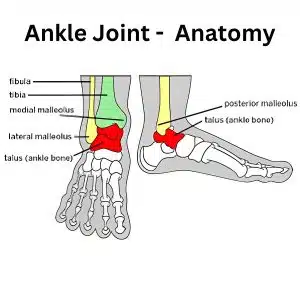Ottawa Ankle Rules

If you’ve ever sprained your ankle, you understand how painful and inconvenient it can be. But how can you tell if it’s a simple sprain or a more serious injury? This is when the Ottawa Ankle Rules come into play. We’ll look at what the Ottawa Ankle Rules are, how they work, and why they’re significant in this blog post.
What are the Ottawa Ankle Rules?
The Ottawa Ankle Rules are a set of rules created in 1992 by a group of doctors in Ottawa, Canada. The rules are intended to assist healthcare providers in determining whether an ankle injury necessitates an X-ray or other imaging test. The regulations are founded on the premise that X-rays are not always necessary for ankle injuries and can expose patients to unneeded radiation and expense.

What are the 5 Ottawa Ankle Rules
The Ottawa Ankle Rules consist of 5 criteria or questions that healthcare professionals use to assess ankle injuries. These 5 criteria are:

- Bone tenderness at the posterior edge or tip of the lateral malleolus.
- Bone tenderness at the posterior edge or tip of the medial malleolus.
- Inability to bear weight both immediately and in the emergency department for four steps.
- Bone tenderness at the base of the fifth metatarsal.
- Bone tenderness at the navicular bone.
However, healthcare providers may modify the Ottawa Ankle Rules in some circumstances to better suit their patient demographic or clinical setting. A study published in the European Journal of Emergency Medicine, for example, discovered that a modified version of the Ottawa Ankle Rules with additional criteria, such as the presence of swelling and the ability to walk immediately after the injury, had higher sensitivity and specificity than the original Ottawa Ankle Rules.
Modified Ottawa Ankle Rules
While the original Ottawa Ankle Rules are widely accepted as a reliable tool for diagnosing ankle fractures, regional modifications have been made to improve their sensitivity and specificity. To improve the accuracy of diagnosing ankle fractures in Asian populations, the Singapore ankle rules were developed to include an additional criterion of “inability to perform a single-leg hop.” The Manchester Ankle Rules were devised in the United Kingdom to incorporate tenderness above the distal tip of the posterior malleolus as an additional requirement. Several regions, like Europe and Australia, have adopted similar changes to increase the accuracy of the Ottawa Ankle Rules for their individual populations.
How does this work?
The Modified Ottawa Ankle Rules are a set of questions that healthcare providers ask patients who have ankle injuries. The questions assist in determining whether the injury is a simple sprain or a more serious injury that necessitates an X-ray. Among the questions are:
- Are you able to take four steps immediately after the injury occurred?
- Is there any pain in the malleolar zone (the bony parts on the inside or outside of the ankle)?
- Is there any pain in the midfoot zone (the area between the ankle and the toes)?
If you answered “yes” to any of these questions, an X-ray is recommended. If the response is “no” to all of these questions, an X-ray is usually not required.
Ottawa Ankle Rules Age
Applying Modified Ottawa Ankle Rules to Children
Applying the Ottawa Ankle Rules to children is an important consideration in clinical practice. Because children’s bones are more malleable and less prone to fracture than adults’, the traditional Ottawa Ankle Rules are less sensitive for diagnosing ankle fractures in children.
Differences in Criteria for Different Age Groups
To address this, modifications have been made to the Ottawa Ankle Rules for children, with different criteria used for different age groups. Any tenderness or inability to bear weight in children under the age of five is considered a positive finding. For children between the ages of 5 and 12, additional criteria are added, including discomfort at the base of the fifth metatarsal and the navicular bone.
Benefits and Challenges of Using Age-Appropriate Criteria
There are various advantages to using age-appropriate criteria for diagnosing ankle fractures in children. It can assist healthcare personnel in minimizing needless radiation exposure from imaging tests, cutting healthcare expenses, and lessening the time of emergency department visits. Moreover, employing age-appropriate criteria can assist enhance the accuracy of ankle fracture diagnoses in children, leading to better patient outcomes.
However, there are certain drawbacks to adopting age-appropriate criteria to diagnose ankle fractures in children. Healthcare professionals may be unfamiliar with these criteria and may require additional training to apply them correctly. Furthermore, if various criteria are used for different age groups, it might lead to confusion or errors in diagnosis.
Ottawa Ankle Rules Mnemonics
The “Can’t Tolerate Any Weight” mnemonic is a tool that helps healthcare practitioners remember the Ottawa Ankle Rules criteria. The mnemonic stands for:
- Can’t bear weight for four steps both immediately and in the emergency department
- Tenderness at the posterior edge or tip of the lateral malleolus
- Tenderness at the posterior edge or tip of the medial malleolus
- Tenderness at the base of the fifth metatarsal
- Tenderness at the navicular bone
The mnemonic is useful because it allows healthcare professionals to recall all of the criteria required for applying the Ottawa Ankle Rules quickly and easily. This can be particularly valuable in emergency situations where time is of the essence.
Several mnemonics have also been devised to assist healthcare practitioners in remembering the Ottawa Ankle Rules requirements. For example, the acronym “PELVIS” stands for:
Pain at the malleoli
Edema at the malleoli
Limitation of ankle joint motion
Visible deformity
Inability to bear weight
Sustained pain in the midfoot or navicular
Similarly, the “RICE” mnemonic (Rest, Ice, Compression, Elevation) can aid healthcare personnel in remembering the initial therapy for ankle injuries. While these mnemonics may not be as precise to the Ottawa Ankle Rules as the “Can’t Tolerate Any Weight” mnemonic, they can still be useful aids in detecting and treating ankle ailments.
Why are the Ottawa Ankle Rules important?
The Ottawa Ankle Rules are significant for several reasons. First, they assist medical personnel in avoiding pointless imaging procedures and X-rays, which can save patients money and lower their radiation exposure. Second, they assist healthcare professionals in making more accurate diagnoses and providing appropriate ankle injury treatment. Finally, the Ottawa Ankle Rules can help reduce wait times in emergency rooms and other healthcare settings by allowing healthcare professionals to prioritize patients based on the severity of their injuries.
Conclusion
The Ottawa Ankle Rules are a valuable set of rules that can assist healthcare practitioners in determining if an ankle injury necessitates an X-ray or other imaging test. Following these criteria allows healthcare providers to give more accurate diagnoses, save patients money, decrease radiation exposure, and prioritize patients depending on the severity of their injuries.
References:
- Stiell IG, Greenberg GH, Wells GA, et al. Prospective validation of a decision rule for the use of radiography in acute ankle injuries. JAMA. 1993;269(9):1127-1132.
- International Federation of Emergency Medicine. Ottawa ankle rules. https://www.ifem.cc/wp-content/uploads/2016/03/Ottawa-Ankle-Rules.pdf. Accessed March 28, 2023.
- American College of Emergency Physicians. Clinical policy for the initial approach to patients presenting with ankle injuries. Ann Emerg Med. 2003;41(3):421-439.
You May Also Like
(To learn more about diagnosing Hip & Lower Back Pain, you may want to check out our previous post on the Faber test )
- Tips for Getting Better Sleep with Anxiety in 2024
- Split Renal Test: The Best Way to Diagnose Dangerous Kidney Problems in 2024
- Revolutionizing Treatment-Resistant Schizophrenia Solutions: Unleashing Hope in 2024
- Demystifying Obsessive-Compulsive Disorder in 2024: Understanding OCD from the Inside Out
- Unmasking the Mind: Can the DAP Test Truly Decode Your Mind in 2023?
